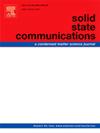Cesium-based perovskite hydrides: A theoretical insight into hydrogen storage and optoelectronic characteristics
IF 2.4
4区 物理与天体物理
Q3 PHYSICS, CONDENSED MATTER
引用次数: 0
Abstract
This study comprehensively investigates the structural, hydrogen (H2) storage, optoelectronic, mechanical, and thermodynamic properties of Cs2ABH6 (A = Na, Al; B=In, Tl) double perovskite (DP) hydrides. The exploration of novel and promising hydride perovskite materials has attracted significant interest for hydrogen storage and related applications. The stability of the cubic structure was predicted based on formation energy, tolerance factor, octahedral factor, and phonon dispersion curves. Hydrogen storage properties, including gravimetric and volumetric capacities, along with desorption temperatures, were carefully calculated. For instance, the gravimetric and volumetric hydrogen storage capacities are determined to be 1.48 wt% and 14.18 gH2/L for Cs2NaInH6, 1.46 wt% and 14.51 gH2/L for Cs2AlInH6, and 1.20 wt% and 14.18 gH2/L for Cs2AlTlH6. Additionally, the hydrogen desorption temperatures were found to be 492.7 K, 534.15 K, and 536.8 K for Cs2NaInH6, Cs2AlInH6, and Cs2AlTlH6, respectively. Electronic band structure calculations using the HSE06 hybrid functional reveal that Cs2NaInH6 exhibits a direct band gap of 2.17 eV, whereas Cs2AlInH6 and Cs2AlTlH6 display indirect band gaps of 1.13 eV and 1.79 eV, respectively. The optical properties were thoroughly analyzed, indicating the materials' suitability for UV-based optoelectronic devices. Elastic constants were evaluated to meet stability criteria, ensuring the mechanical stability and brittleness of the solids. The calculated Zener anisotropy index (AZ) and equivalent anisotropy (Aeq), along with 3D elastic moduli visualizations from ELATE, confirm the compounds' anisotropic behavior. Furthermore, the Helmholtz free energy (F), internal energy (E), entropy (S), and specific heat capacity (Cv) were computed from the phonon density of states. This investigation identifies Cs2ABH6 (A = Na, Al; B=In, Tl) as a promising candidate for advanced hydrogen storage and optoelectronic applications.
铯基钙钛矿氢化物:氢存储和光电子特性的理论见解
本研究全面考察了Cs2ABH6 (A = Na, Al;B=In, Tl)双钙钛矿(DP)氢化物。新型氢化物钙钛矿材料的开发已经引起了人们对储氢和相关应用的极大兴趣。根据地层能量、容差因子、八面体因子和声子色散曲线预测了立方结构的稳定性。储氢性能,包括重量和体积容量,以及解吸温度,都经过仔细计算。例如,Cs2NaInH6的重量和体积储氢量分别为1.48 wt%和14.18 gH2/L, Cs2AlInH6的重量和体积储氢量分别为1.46 wt%和14.51 gH2/L, Cs2AlTlH6的重量和体积储氢量分别为1.20 wt%和14.18 gH2/L。此外,Cs2NaInH6、Cs2AlInH6和Cs2AlTlH6的氢解吸温度分别为492.7 K、534.15 K和536.8 K。利用HSE06杂化泛函进行电子能带结构计算发现,Cs2NaInH6的直接带隙为2.17 eV,而Cs2AlInH6和Cs2AlTlH6的间接带隙分别为1.13 eV和1.79 eV。对材料的光学性能进行了深入分析,表明材料适合用于基于uv的光电器件。评估弹性常数以满足稳定性标准,确保固体的力学稳定性和脆性。计算的Zener各向异性指数(AZ)和等效各向异性(Aeq),以及ELATE的三维弹性模量可视化,证实了化合物的各向异性行为。此外,从态声子密度计算了亥姆霍兹自由能(F)、内能(E)、熵(S)和比热容(Cv)。本研究鉴定出Cs2ABH6 (A = Na, Al;B=In, Tl)作为先进储氢和光电子应用的有前途的候选者。
本文章由计算机程序翻译,如有差异,请以英文原文为准。
求助全文
约1分钟内获得全文
求助全文
来源期刊

Solid State Communications
物理-物理:凝聚态物理
CiteScore
3.40
自引率
4.80%
发文量
287
审稿时长
51 days
期刊介绍:
Solid State Communications is an international medium for the publication of short communications and original research articles on significant developments in condensed matter science, giving scientists immediate access to important, recently completed work. The journal publishes original experimental and theoretical research on the physical and chemical properties of solids and other condensed systems and also on their preparation. The submission of manuscripts reporting research on the basic physics of materials science and devices, as well as of state-of-the-art microstructures and nanostructures, is encouraged.
A coherent quantitative treatment emphasizing new physics is expected rather than a simple accumulation of experimental data. Consistent with these aims, the short communications should be kept concise and short, usually not longer than six printed pages. The number of figures and tables should also be kept to a minimum. Solid State Communications now also welcomes original research articles without length restrictions.
The Fast-Track section of Solid State Communications is the venue for very rapid publication of short communications on significant developments in condensed matter science. The goal is to offer the broad condensed matter community quick and immediate access to publish recently completed papers in research areas that are rapidly evolving and in which there are developments with great potential impact.
 求助内容:
求助内容: 应助结果提醒方式:
应助结果提醒方式:


